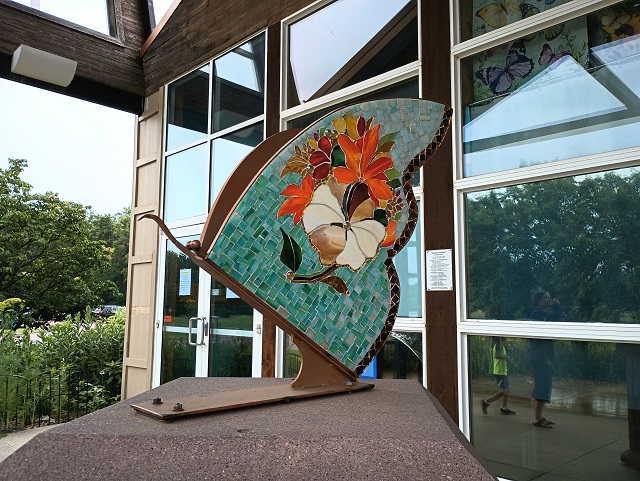entranceWhile in Sioux Falls, South Dakota for the LWMS convention I spent part of a day enjoying the Butterfly House and Aquarium. It wasn’t until I was buying my ticket that I learned that it was part of the Great Plains Zoo. I also found that it was a bit smaller of an aquarium then I was expecting, but the butterfly housing area was amazing. It was definitely a great way to spend a few hours and learn about some of the amazing animals in their care.
The main entrance is near the aquarium, so I made my way there first. Even though the building was smaller than I was thinking it would be, they did have quite a few aquatic animals. I don’t remember all of them, but I do remember they had a few Moon Jelly fish. I love how they light the tanks with different colors. They did the same thing at the Sea Life Kansas City Aquarium in Kansas, MO. Here are a few fun facts about Moon Jelly Fish:
- Benefit from overfishing, ocean warming, and pollution
- Very diverse and live in water temperatures ranging from 21 to 84 degrees Fahrenheit
- Live in both tropical and subtropical environments
- Are a common food source for many marine species including the largest marine turtles species in the works: The Leatherback Sea Turtle
- Have the ability to regenerate parts of their body when minimal damage occurs
- Are indicators of the health of the oceans – increased populations of jellyfish are often indicators of ocean acidification.
While exploring the Butterfly House and Aquarium, I saw quite a few Yellow and Blue Tang. Sadly the Blue Tang overexploitation and destructive fishing prictices are the main threats posted to Blue Tangs. When faced with danger or dark spaces, Blue Tangs can make themselves semi-transparent in order of hide from predators. While Yellow Tangs are often collected for the hobbyist sector, many have been collected in ways the can be detrimental to the animal as well as the marine environment. Like the Blue Tang, the Yellow Tangs bright yellow color fades at night to help hide itself from predators.
One of the most interesting fish I saw at the Butterfly House and Aquarium had to be the Lionfish. They look very strange to me, lol. Here is a little information about Lionfish. While they are native to the Indo-Pacific coral region, they are considered an invasive species in the Atlantic coral region, and have been contributing to the population levels of coral fish. As such, this is an extremely serious problem because they are out-breeding, out-competing, and out-living native fish stocks and other marine species. The consequences of the lionfish invasion threatens food security and economies affecting over one hundred million people. If left unchecked, lionfish will ultimately cause the destruction of the reefs, native fish stocks, and the livelihood of those dependent upon them.
There were so many different types of fish which I don’t remember, but of course I do remember seeing a few clown fish and heard a little girl say “Look mama, Nemo!”. I thought that was cute and a great way to end my exploration of the aquarium section.
I made my way to the butterfly section of the Butterfly House and Aquarium to see what types of butterflies I could see and learn about. One of the first things I checked out was a dispaly where I learned that they have many types of butterflies from many different regions. Above is a picture showing where they get their butterflies. As you can see, many come from North and South America.
Another section I made my way to before checking out all the beautiful butterflies, is the area where they hold their chrysalis. For those that may not know, chrysalis is a butterfly caterpillar’s pupa stage, often seen hanging from a leaf or twig, until the butterfly is ready to emerge from its cocoon. I can image that would be really cool to see one day. I have seen them rocking and shaking a little, but never actually emerge. One worker at the Butterfly Pavilion in St. Martin told me that when they start moving, they often break free of their cocoon later the evening or into the morning.
I left that area and walked around the very peaceful butterfly house area (not sure what it is called). They even had a nice gazebo to sit in to watch them fly around and just relax. Like I said, they have many types and I couldn’t have named many in this post even if I remember them, lol. Of course they had some beautiful blue morph’s, monarchs, red postman Heliconius, and a bunch of swallowtails.
One surprise I wasn’t expecting was to see some Musk Turtles. According to the Butterfly House and Aquarium, Loggerhead musk turtles are important prey items for a wide variety of species. Alligator snapping turtles, cottonmouth snakes, American alligators, and even humans are known to eat them. Their eggs are also commonly eaten by birds and mammals such as raccoons. Musk turtles lay between two and nine eggs in shallow burrows, often near other musk turtle nests. Predators commonly raid their nests, with up to 75% of nests being destroyed. Because of this, only about 15% of hatchlings are successful.
I had a great time walking around the Butterfly House and Aquarium. One of the most interesting things that I wanted to share before ending this post, is that about halfway through walking around the butterfly area, one attached itself to my sleeve and stayed there for almost an hour. I couldn’t believe it, and even had a few people comment that it must really like me, lol. Below is a picture of it J Hope you enjoyed learning a little bit about my visit. Here is a link to their website if you want to plan your own visit.
Butterfly House and Aquarium Visitor Information
Address:
4320 S Oxbow Ave
Phone:
Hours:
Open year-round from 10 am – 4 pm (final admission at 3:30 pm)
Price:
- Infant (Under age 2): Free
- Youth (Ages 2-17): $11 + Tax
- Adult (Ages 18-59): $15 + Tax
- Senior (Ages 60+): $13 + Tax
Parking:
Free















